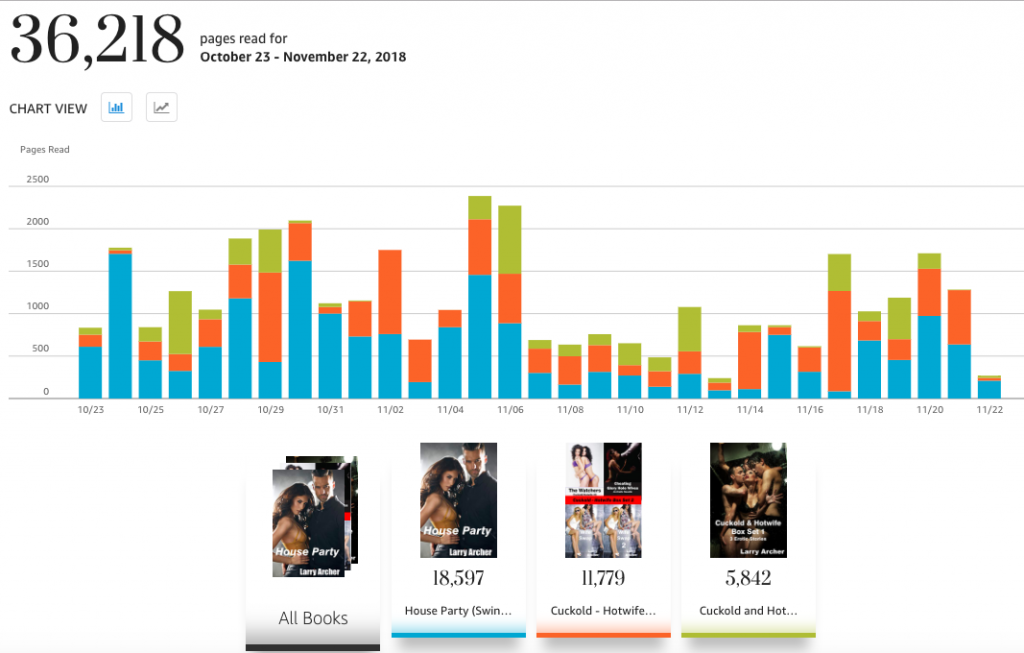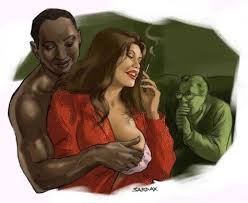[I am posting this on behalf of Jean Roberta, who is having computer problems. You can contact her at jean2551englishlit [at] yahoo [dot] ca ~ Lisabet]
By Jean Roberta
This is the season when I sometimes wish I had written more winter-holiday romances: stories about a man and a woman finding love in picturesque snowy landscapes (on a ski trip, lost in the woods, or under the city lights surrounded by decorated Yule trees) with little or no explicit sex. Stories like this get posted, published, and reposted a lot during this season. I was invited to send any of my holiday romance stories to be reprinted. Alas, none of my stories fit.
There is “Amanda and the Elf” (under 2K), a raunchy little piece in which Amanda, an exhausted divorced mother of two children, is visited on Christmas Eve by a studly elf she hasn’t seen since she was a horny teenager. (Hint: he is really a masturbation fantasy, small enough not to be threatening, but with superhuman ability to satisfy any woman who wants him.) Although the elf is likely to show up in Amanda’s life again, their relationship doesn’t exactly have a quality of “happily ever after.”
This story first appeared in Merry XXXmas, a holiday anthology edited by Alison Tyler (Cleis Press, 2005).
Then there is my historical story of clandestine lesbian love, “A Visit from the Man in Red.” One of the women has a child by an abusive ex-husband, as well as a set of parents who expect her to find and marry a better man as soon as possible. The year in 1968, when a sweeping Omnibus Bill modernized Canadian culture by legalizing sex between men and making divorce easier to get. The two women arrange their own secret Christmas celebration, and when the ex-husband threatens to ruin it, the day is saved by a man in a red uniform: a closeted gay “brother” in the Royal Canadian Mounted Police. Again, this is not really a romance.
The story was first published in Naughty or Nice? – another holiday anthology from Cleis, edited by Alison Tyler (2007). Then it appeared in my single-author collection of women’s erotica, The Princess and the Outlaw: Tales of the Torrid Past from Lethe Press in 2013.
Then there is “The Feast of the Epiphany,” a story with no explicit sex in which two women and two men go out for supper on “Ukrainian Christmas,” as it is called on the Canadian prairies: January 6 or 7, when Christmas is celebrated in the Eastern Orthodox Catholic Church. The narrator, a divorced woman who is trying to find her way into the lesbian community, has a crush on the other woman, who seems strong, capable, and comfortable with her identity as a dyke. The men are also mutually attracted, but one believes that monogamy is part of heteronormative oppression, and he has had a “friendship with benefits” with the supposed dyke. The other man feels strongly about the need for commitment; he was disowned from his Orthodox Jewish family for being gay, and doesn’t want to waste his love on someone who can’t be loyal. During a lively discussion, the waiter (who is also gay, of course) jumps in as a mediator. There is a fairly happy ending for all the characters, but is this “romance?” Maybe, but it’s not highly seasonal.
This story was accepted (somewhat to my surprise) for Coming Together: Into the Light, a more-or-less erotic anthology of stories about revelations, edited by Alessia Brio, published by Phaze Publications in 2010 as part of an erotic series that raises money for worthy causes. This volume won an EPPIE (Electronically Published Internet Connection) award.
When one mushy movie after another with “Christmas” in the title shows up on my TV screen, I sometimes wonder why I haven’t written a narrative like these. They look easy to write, and I seem to be capable of throwing characters together.
However, as I was told by one of my English profs many years ago, you can’t write a convincing plot about something you don’t believe in. This was his warning to those of us who might have the hubris to think we could make lots of money writing traditional romances for Harlequin in the U.S. or Mills and Boone in the U.K.
I have written about sexual relationships between men and women, and in some cases, I’m very fond of my characters and want them to be happy together. (My “bawdy novella, The Flight of the Black Swan, is set in the1860s, and features an official marriage which serves as cover for two same-gender love affairs. This book is sexually classified as “bisexual.”)
In general, however, I don’t believe that the social, legal, and economic inequality between men and women which prevailed in Western society for centuries leads to True Love. I suppose I’m a feminist killjoy. There have always been loopholes in the patriarchy, and women have made great strides in the last fifty years, but if you think male violence against females is fading into history, you are out of the loop. Every step forward made by women seems to be met by enormous resentment from men.
To throw a hero and a heroine together, I need them both to be exceptional, and I need their circumstances to be unusual. A sprig of mistletoe isn’t enough to persuade me that two people who have serious objections to each other (the “Dearest Enemy” romance trope that I’ve written about elsewhere) can suddenly fall in love, or recognize that love was there all along. The magic of the season doesn’t seem like an adequate reason why two people would want to spend their lives together. If it wouldn’t work in March or September, it wouldn’t work better in December.
I could refer you to several recent posts in social media about the unpaid “emotional labour” largely done by women, especially during the winter holidays, when gifts must be bought, feasts cooked, houses decorated, and social events planned. In real life, all this work doesn’t usually lead to melting glances between an exhausted woman and a typically clueless man who has no idea what she wants him to do.
In my own real life, I am living happily with my spouse, the woman I have been with since 1989. (Next summer, we plan to put on some sort of celebration for the thirtieth anniversary of our first overnight date.) We love this time of year because the break from paid work gives us a chance to become couch potatoes watching mushy movies together. Maybe I should write about that.


















